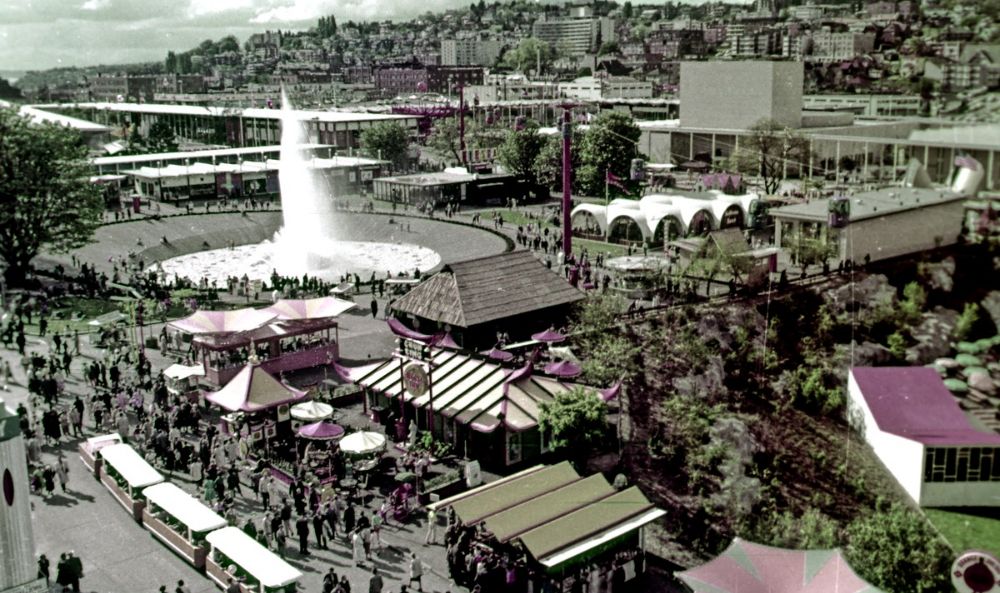
Historical bursts of growth lay groundwork for civic celebrations in Seattle. I’m reminded of this, for next month is the 60th anniversary of the 1962 Seattle World’s Fair, which also grew out of a local burst of economic growth.
The 1893 World’s Columbian Exposition in Chicago, the 1901 Pan American Expo in Buffalo, New York, and the 1905 Portland, Oregon exposition were milestones illustrating such civic breast-beating.
The exposition that most influenced Seattle was the 1893 Columbian Exposition in Chicago. That show featured a gleaming “White City” (largely constructed of plaster of Paris – a gypsum derivative – and later totally dismantled). The formula was set in place: family and adult entertainment; history and art exhibits; food and drink everywhere; and showcases for American inventors, architects, and tinkerers.
There is also a personal connection, for the 1893 Columbian event helped instill “Expo Fever” within my own family. My grandmother, Julia Gwynn Smith Rochester, won third prize in classical singing at the Columbian Exposition. Her brother-in-law, Percy Rochester, was Washington State’s Deputy Commissioner to the same Chicago show.
This family activity was extended by Junius, my father’s brother, who at age 15 sold water at the 1904 St. Louis fair, and my father, Alfred R. Rochester, who at age 14 operated a bread-slicing machine at Seattle’s 1909 Alaska-Yukon-Pacific Exposition (currently the University of Washington campus).
Family “Expo Fever” recurred in the 1950s when my father joined a small luncheon group at Seattle’s Washington Athletic Club. Quoting from the 2011 HistoryLink history of the fair: “In January 1955, over martinis at the Washington Athletic Club . . . Rochester broached the subject (of a fair) with Seattle Chamber of Commerce Director Don Follett and with Ross Cunningham, a reporter (and editor) for The Seattle Times. The three agreed that Rochester should try to gain the city council’s support.”
The city council adopted my father’s resolution authorizing the investigation of a Seattle world’s fair. State Sen. William Goodloe picked up the idea, helping authorize $5,000 for a committee to pursue the project. Governor Arthur B. Langlie signed the bill into law.
The World’s Fair Commission held its first meeting at Seattle’s Olympic Hotel, with Eddie Carlson presiding over a group of local business leaders. Among the most important decisions of the Commission was finding a site for the Exposition. The chosen neighborhood was sometimes referred to as “Potlatch Meadows,” a nod to early Native use of the area. Later, David and Louisa Denny, the first white residents, called it “the prairie.” It eventually became a fading Harrison neighborhood, and today it is Seattle Center.
After the Seattle World’s Fair closed, visitors later enjoyed nearby expositions such as environmentally-themed Spokane’s Expo 74, and Vancouver, B.C.’s transportation-themed Expo 86.
By law, every exposition – except Seattle’s – was dismantled or plowed under. Seattle shrewdly used the Fair to construct lasting buildings such as the Monorail, the iconic Space Needle, the International Fountain, the Pacific Science Center, Chihuly Garden and Glass, the Marion Oliver McCaw Hall, the Cornish playhouse, a sports stadium, and Center House.
The genesis of Seattle’s 1962 fair can be explained by economic circumstances (the 1960s were relative boomtimes); strong civic leadership that wanted to replace a run-down neighborhood and stir tourism; an ideal geographical setting; and the successful templates of earlier world’s fairs.
Are we likely to witness another exposition on the scale of the seminal, creative expositions at Chicago, New York, St. Louis, San Francisco, or Seattle? That’s unlikely. Impediments to such large-scale shows today include overall expense, the expanding importance of electronic gadgets, sophisticated rival entertainments such as Disney World.
In any case, Happy 60th to Century 21, popularly known as the Seattle World’s Fair. It climaxed and helped to spawn years of growth and civic confidence.
Discover more from Post Alley
Subscribe to get the latest posts sent to your email.

Junious, thank you for the marker and recollection. -Howard Wright
Great work Junious! Glad to see the history recalled correctly!
One-time Portland Mayor (and Tavern Owner) Bud Clarke, interviewed about the difference between Portland and more prosperous Seattle: “The Fair did it.”
To Howard Wright: Thanks. And I’m aware of your family’s pace-setting contributions to the Seattle Center and much more.
To Art Langlie: Your family members have always been available to the citizens of our state, and never avoided working with “the other side” to get the job done.
To Jean Godden: Bud Clarke, of the famous “exposing yourself to art” image, was one of a kind. Thanks.
Junius
Our state was very lucky to get two World’s Fairs in 12 years.
I recommend a book by UW historian John Findlay, “Magic Lands” (1992) that recounts the history of Seattle Center as an effort at clearing undesired areas and creating a suburban, grassy, auto-free zone in the city, antidotes to the messy chaos of big cities. Seattle Center is, in many ways, an exercise in nostalgia, even though billed as being about the brave new future.
Spokane also revitalized a dying part of town with it’s exposition.
Great Fair, but a really dumb theme song:
Meet me in Seattle at the Fair,
If you’re gonna meet me meet me there,
Meet me in Seattle,
That’s where I’ll be at’ll,
Meet me in Seattle at the Fair….
Gordon: We didn’t have a notable theme but musical memories of C-21 are high: Stravinski leading the Seattle Symphony in his own Firebird Suite; Van Cliburn playing Tchaikovsky; and Jackie Souders leading his band daily through the fairground streets.
Junius
Hey, I loved The Fair. I worked as a guide and narrator on the SS Sightseer. We started at Pier 66, went around Queen Anne and Magnolia, through the Locks and finished at Leschi, then picked up another bus load of tourists for the return.
Once on the Eastbound leg, a woman looked at the Space Needle from Lake Union. “Young man,” she said, “I don’t understand why it revolves. It looks the same from all sides.”